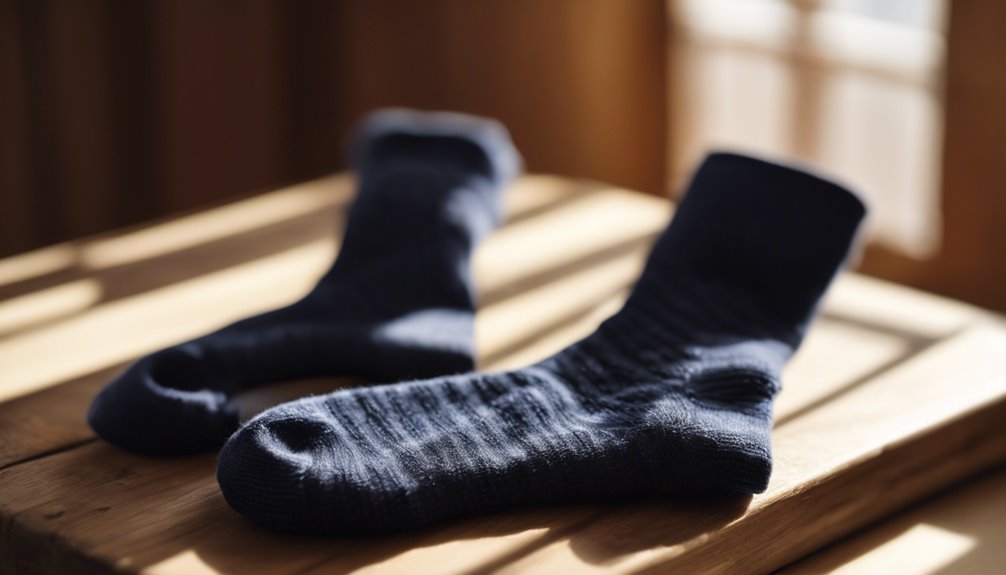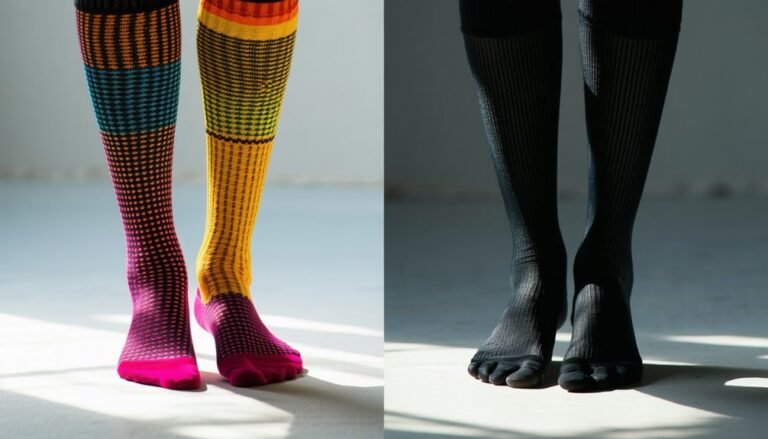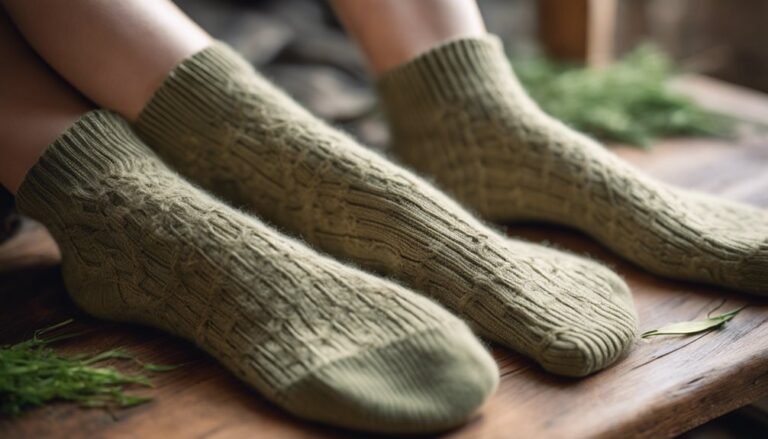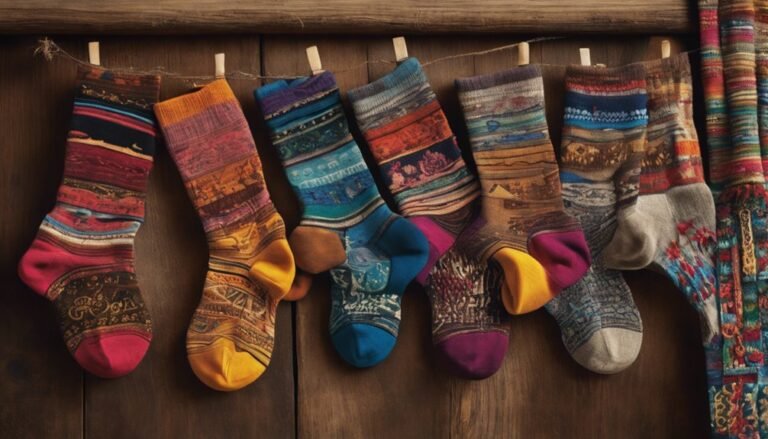Can Socks Actually Reduce Foot Odor? Science Says Yes
Yes, the right socks can definitely reduce foot odor. They're designed with advanced materials that manage moisture and inhibit bacterial growth, two main causes of odor. Breathable fabrics allow airflow, while antimicrobial treatments help eliminate odor-causing bacteria. Proper fit and thoughtful design further enhance comfort and effectiveness. Incorporating daily foot care habits, like washing and drying your feet, alongside choosing quality socks can lead to fresher feet. Discover more about how these factors work together for best results.
Understanding Foot Odor: Causes and Contributing Factors
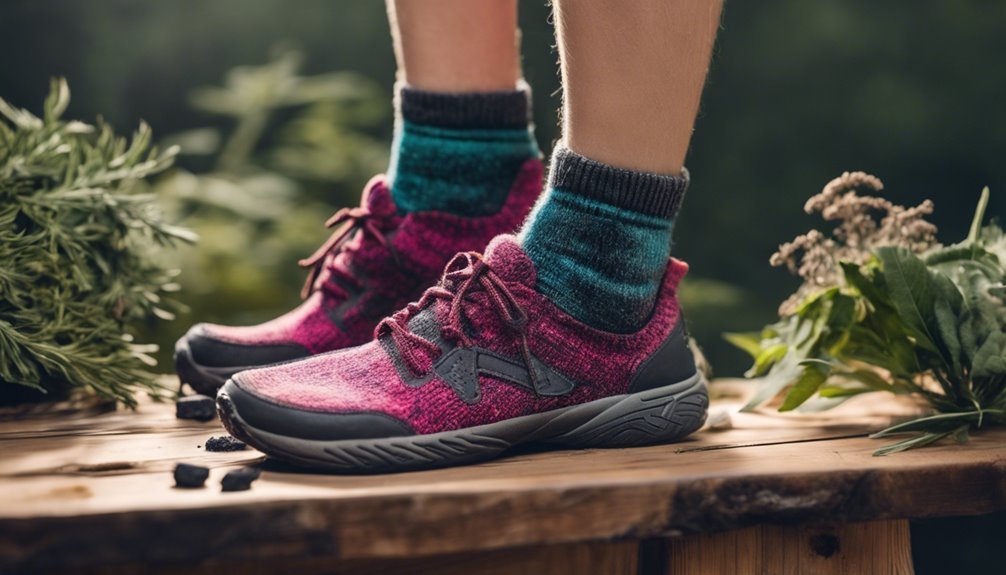
Although foot odor is a common issue, understanding its underlying causes can help you manage it effectively. Primarily, bacterial growth is responsible for that unpleasant smell. When your feet sweat, moisture creates an ideal environment for bacteria to thrive. These microbes break down sweat and skin cells, producing odor as a byproduct. To combat this, maintaining proper foot hygiene is essential. Regularly washing your feet and thoroughly drying them can greatly reduce bacterial growth. Additionally, opting for breathable footwear and changing socks daily helps keep your feet dry and odor-free. By understanding these factors, you can take proactive steps to minimize foot odor and enjoy the freedom of fresh-smelling feet. Remember, prevention is key in this battle against odor.
The Role of Moisture in Foot Odor
Moisture plays a significant role in the development of foot odor. Excess moisture creates an environment where bacteria growth thrives, leading to unpleasant smells. Understanding how moisture absorption impacts your feet is essential for odor management. Here are four key points to reflect upon:
- Sweat Production: Your feet sweat more than other body parts, increasing moisture levels.
- Bacteria Interaction: Bacteria feed on sweat, releasing odor-causing compounds.
- Footwear Choices: Non-breathable shoes trap moisture, exacerbating the problem.
- Sock Selection: Choosing socks with high moisture absorption can help keep your feet dry and reduce bacteria growth.
Materials Matter: Choosing the Right Sock Fabric
When selecting socks, the fabric you choose plays an important role in managing foot odor. Natural fibers like cotton offer breathability, while synthetic options often feature moisture-wicking properties that keep your feet dry. Additionally, some socks come with antimicrobial treatments that can further reduce odor, making it essential to take into account these factors for best comfort.
Natural vs. Synthetic Fibers
Choosing the right sock fabric is essential, especially if you're concerned about foot odor, as the materials used can greatly affect breathability and moisture management. Natural fibers like cotton and wool allow for better air circulation, helping to reduce sweat accumulation. On the other hand, synthetic fibers, such as polyester and nylon, can provide durability and stretch but may trap moisture.
Consider these factors when selecting your socks:
- Breathability: Natural fibers often offer superior airflow.
- Moisture Management: Synthetic options may retain sweat.
- Comfort: Natural fibers tend to be softer against the skin.
- Durability: Synthetic fibers usually withstand wear and tear better.
Moisture-Wicking Properties
While selecting socks, it is important to take into account their moisture-wicking properties, as these can greatly influence your comfort and hygiene. Effective moisture management is key to keeping your feet dry, which in turn helps minimize odor. Look for socks made from materials like merino wool or synthetic blends that enhance sock breathability. These fabrics pull moisture away from your skin and allow it to evaporate, reducing the likelihood of dampness that can lead to unpleasant smells. Additionally, breathable socks promote airflow, further aiding in temperature regulation. By prioritizing moisture-wicking capabilities, you empower yourself to enjoy activities without worrying about foot odor, ensuring a more comfortable experience. Remember, the right sock can make all the difference.
Antimicrobial Treatments Explained
Although foot odor can be a common issue, selecting socks with antimicrobial treatments can considerably mitigate this problem. These specialized sock treatments incorporate antimicrobial agents that actively combat odor-causing bacteria. Here's what you should know:
- Types of Antimicrobial Agents: Common agents include silver, copper, and zinc, each offering unique odor-fighting properties.
- Durability: Many treatments are designed to withstand multiple washes, maintaining effectiveness over time.
- Comfort: Antimicrobial socks often enhance overall comfort by reducing moisture and irritation.
- Material Choices: Look for blends that combine synthetic fibers with natural materials for peak performance.
Antimicrobial Technologies in Sock Production
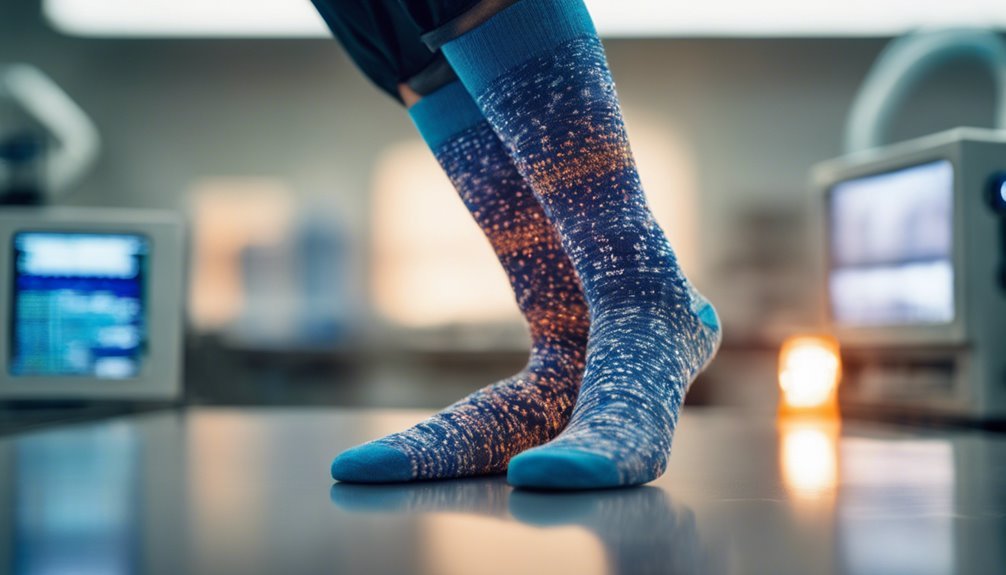
In sock production, various types of antimicrobial agents play an essential role in combating foot odor. Innovations in the manufacturing process enhance these agents' effectiveness and guarantee they remain effective over time. Understanding these technologies can help you choose socks that not only feel good but also keep your feet fresh.
Types of Antimicrobial Agents
As you consider the various options for combating foot odor, it is essential to understand the different types of antimicrobial agents used in sock production. These agents can greatly enhance your sock's effectiveness. Here are four primary types:
- Natural Ingredients: Such as bamboo or tea tree oil, which possess inherent antibacterial properties.
- Silver Nanoparticles: Known for their ability to inhibit bacterial growth through their unique structure.
- Copper Compounds: Effective against odor-causing bacteria and fungi.
- Synthetic Additives: Often engineered for long-lasting effects and durability, providing a barrier against odor.
Manufacturing Process Innovations
Recent advancements in manufacturing processes have greatly impacted the effectiveness of antimicrobial technologies in sock production. By utilizing sustainable materials, manufacturers are not only addressing foot odor but also promoting environmental responsibility. Advanced manufacturing techniques, such as integrating antimicrobial agents directly into fibers, enhance durability and effectiveness against odor-causing bacteria. This innovative approach guarantees that the antimicrobial properties last longer, giving you peace of mind with every wear. Additionally, these processes often involve eco-friendly dyes and reduced water usage, aligning with the growing demand for conscious consumerism. As you choose socks, consider those crafted with these innovations, allowing you to enjoy comfort and freshness while supporting sustainable practices. Ultimately, these advancements empower you to make informed choices for both your feet and the planet.
Efficacy and Longevity
While you might expect all antimicrobial socks to perform similarly, the efficacy and longevity of these technologies can vary greatly. Here are four factors to evaluate:
- Material Composition: Different fibers offer varying levels of antimicrobial properties.
- Sock Maintenance: Proper care can enhance durability—neglect can lead to reduced effectiveness.
- Washing Frequency: Regular washing helps maintain cleanliness, but excessive washing may wear down antimicrobial treatments.
- Technology Type: Some antimicrobial treatments are more resilient than others, impacting their lifespan.
Understanding these elements can help you choose the right socks and maintain their effectiveness. Ultimately, your choice and care can greatly influence how well these socks combat foot odor.
The Importance of Fit and Design
When selecting socks, understanding the importance of fit and design can greatly impact your comfort and hygiene. A proper sock fit guarantees that your socks don't bunch or slide down, which can lead to friction and moisture buildup—two primary contributors to foot odor. Look for design features like arch support and cushioning that enhance comfort while also promoting air circulation. Materials that wick moisture can help keep your feet dry, reducing the risk of odor. Additionally, ergonomic designs that contour to your foot shape can prevent blisters and discomfort. By prioritizing sock fit and thoughtful design, you're not just choosing comfort, but also taking proactive steps to maintain foot hygiene and freshness in your daily life.
Daily Habits to Complement Sock Choices
To effectively manage foot odor, it's essential to adopt daily habits that complement your sock choices. Practicing good sock hygiene and foot care can notably enhance your comfort and freshness. Here are some essential habits to integrate into your routine:
- Wash Your Feet Daily: Clean your feet thoroughly, especially between the toes, to remove sweat and bacteria.
- Choose Breathable Footwear: Opt for shoes made from natural materials that allow airflow, reducing moisture buildup.
- Rotate Your Socks: Don't wear the same pair two days in a row; alternating socks helps maintain freshness.
- Dry Your Feet Properly: After washing, dry your feet completely before putting on socks to prevent moisture retention.
Real-Life Success Stories: Socks That Changed the Game
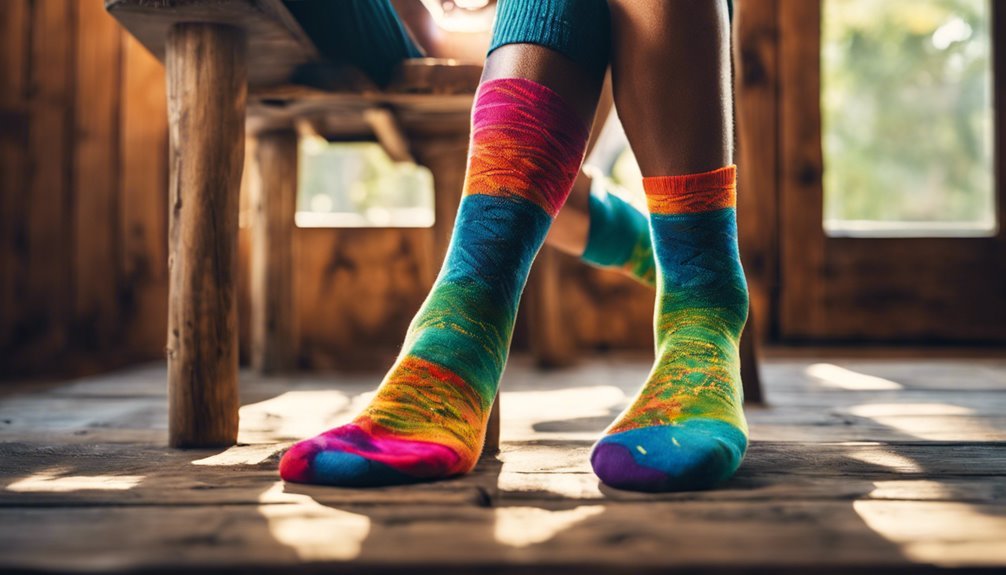
As people increasingly seek solutions to foot odor, innovative sock designs have emerged that promise not just comfort but also effective odor control. Real-life sock testimonials reveal how users have transformed their daily routines. Many share stories of overcoming embarrassing odor experiences, thanks to moisture-wicking materials and antimicrobial treatments. For instance, one user reported that switching to a particular brand eliminated the persistent smell that plagued them after workouts. Another noted a significant reduction in foot sweat, leading to fresher shoes. These success stories highlight the positive impact of specialized socks, encouraging others to embrace the freedom of odor-free living. As these testimonials continue to circulate, it's clear that the right socks can indeed change the game for foot odor sufferers.
Frequently Asked Questions
How Often Should I Change My Socks to Prevent Odor?
To prevent odor, change your socks daily, especially if they're made from moisture-wicking fabrics. Prioritizing foot hygiene and choosing breathable materials can help keep your feet fresh and comfortable, allowing you to enjoy your freedom.
Can Wearing Shoes Without Socks Increase Foot Odor?
Wearing shoes without socks might feel liberating, but it can trap moisture and bacteria, worsening foot odor. Shoe materials also play a role; breathable ones promote foot hygiene, while non-breathable options exacerbate odors.
Do Certain Colors of Socks Affect Foot Odor?
Certain sock colors might influence your perception of foot odor due to color psychology, but it's primarily fabric composition that affects moisture and bacteria. Choosing breathable materials is key to minimizing any odor, regardless of color.
Are There Specific Brands Known for Odor-Reducing Socks?
When considering specific brands for odor-reducing socks, examine brand effectiveness and material comparison. Brands utilizing merino wool or synthetic blends often provide superior moisture-wicking properties, helping to minimize foot odor while maintaining comfort and style.
Can Sock Length Influence Foot Odor Levels?
You might be surprised, but sock length can indeed influence foot odor levels. Ankle socks may allow more airflow, while compression socks can trap moisture, potentially leading to odor. It's all about finding the right balance for comfort.

